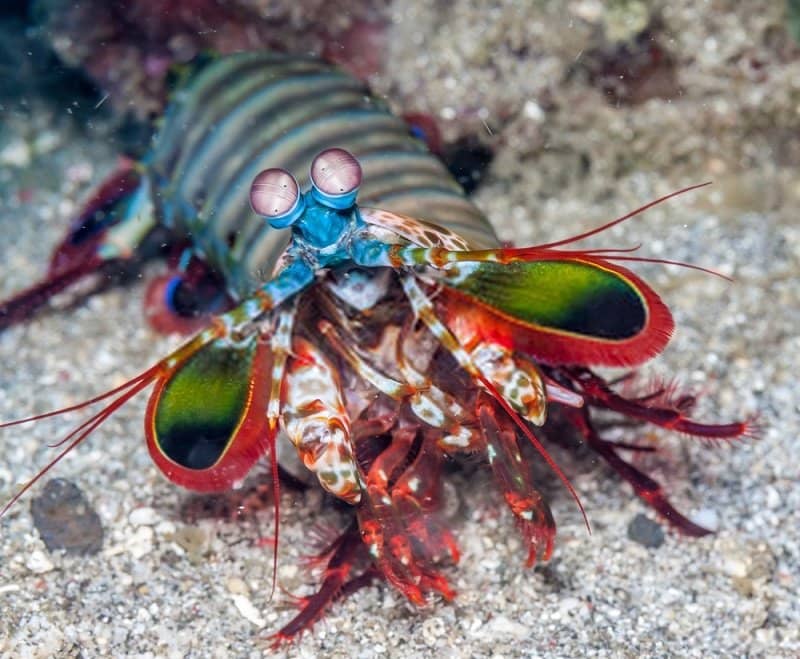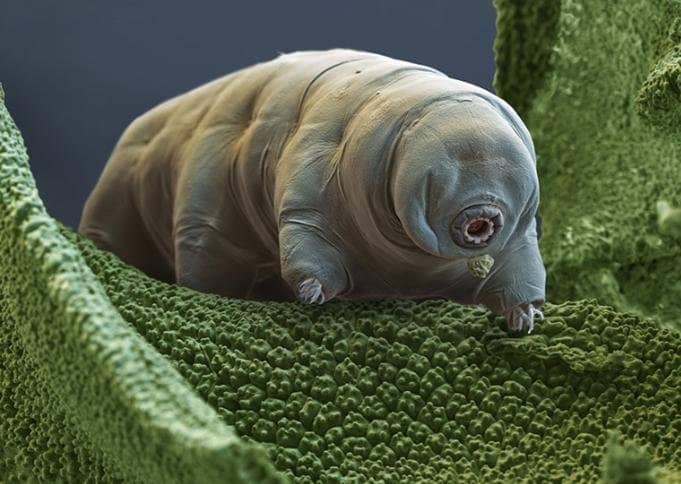The world’s oceans, rivers, lakes, and even underground aquifers are home to an incredible array of weird and wonderful water creatures. These aquatic beings have evolved to thrive in a wide range of environments, from the darkest depths of the ocean to the tiniest freshwater streams. Let’s explore some of the most unique and fascinating water creatures:
Mantis Shrimp

Mantis shrimps are small but incredibly fascinating marine crustaceans known for their extraordinary eyesight and powerful claw strikes. They possess one of the most complex visual systems in the animal kingdom, with 12 to 16 types of photoreceptor cells compared to the three in humans. This enables them to see a wide spectrum of colors, including ultraviolet and polarized light. They use their exceptional vision for hunting prey and communicating with each other through intricate body language. Mantis shrimps also have formidable appendages called “raptorial claws” that strike with astonishing speed and force, capable of breaking the shells of prey or smashing through glass aquarium walls. Their hunting techniques and bright colors make them popular subjects in marine biology and aquariums, where they captivate the attention of curious observers.
Water Bear (Tardigrade)

Water bears, also known as tardigrades, are microscopic aquatic creatures that have gained fame for their extreme resilience. They can survive in various environments, including the deep sea and freshwater habitats. Despite their tiny size, tardigrades are known to withstand extreme conditions such as extreme temperatures, radiation, and desiccation (complete drying out). They achieve this remarkable feat by entering a state called cryptobiosis, essentially suspending their metabolism until more favorable conditions return. Tardigrades are an intriguing subject of study for scientists interested in extremophiles and the potential for life beyond Earth.
Axolotl

The axolotl, native to Mexico, is an aquatic salamander famous for its remarkable regenerative abilities. Unlike most amphibians, axolotls remain in their aquatic larval form throughout their lives, never fully undergoing metamorphosis. What sets them apart is their ability to regenerate lost body parts, including limbs, spinal cord, and even portions of their heart and brain.
This unique regenerative capability has made axolotls a subject of intense scientific research, offering insights into tissue regeneration and potential applications in regenerative medicine for humans. Due to habitat loss and pollution, they are critically endangered in the wild, making them important candidates for conservation efforts.
Blobfish

The blobfish, often humorously dubbed the “world’s ugliest fish,” resides in the deep waters off the coasts of Australia and New Zealand. Its unique appearance is due to its gelatinous flesh, which allows it to withstand the extreme pressure of its deep-sea habitat. When brought to the surface, where pressure decreases, the blobfish loses its shape, resembling a saggy, drooping face. In its natural habitat, it appears less bizarre, thanks to its adaptation to high-pressure environments. Despite its unattractive appearance, the blobfish serves as a reminder of the incredible adaptations that allow life to thrive in the harshest and most remote underwater ecosystems.
Humpback Anglerfish

Anglerfish are deep-sea predators known for their unique and eerie method of hunting. They possess a modified dorsal spine that protrudes from their head like a fishing rod, tipped with a bioluminescent lure. In the pitch-black depths of the ocean, this lure attracts prey by imitating the movements of smaller organisms or even mimicking a glowing worm. Once a curious creature approaches, the anglerfish swiftly captures it with its large mouth filled with sharp teeth. These deep-sea dwellers exhibit sexual dimorphism, where the tiny males permanently attach themselves to the much larger females, providing a continuous supply of sperm for reproduction.
Japanese Spider Crab

The Japanese spider crab is a giant arthropod that inhabits the waters around Japan. It holds the title of having the longest leg span of any arthropod species, with some individuals reaching over 12 feet from claw to claw. These crabs live in deep waters and are known for their slow, deliberate movements. Despite their intimidating appearance, they are primarily scavengers, feeding on dead animals and detritus on the ocean floor. Japanese spider crabs are a testament to the incredible size and diversity of life that can be found in the world’s oceans.
Leafy Seadragon

The leafy seadragon, native to the waters of Australia, is a close relative of the seahorse and shares its penchant for camouflaging. These fascinating creatures have leaf-like appendages all over their bodies, providing exceptional camouflage among seaweed and kelp, making them nearly invisible to predators and prey alike. Their swaying motion further enhances their mimicry of floating seaweed. Leafy seadragons are not strong swimmers, relying on their superb camouflage to avoid detection and ambush small crustaceans and plankton, their primary prey. Their delicate appearance and captivating appearance make them popular attractions in public aquariums.
Harlequin Filefish

The harlequin filefish is a small, vibrantly colored fish found in tropical and subtropical waters. They are known for their striking appearance, with bold patterns of bright colors that serve as a form of aposematism, warning potential predators of their toxicity. These filefish feed primarily on coral polyps, which contain toxins. The harlequin filefish has developed resistance to these toxins, making it one of the few creatures that can safely consume coral.
Pink See-Through Fantasia (Ctenophora)

The Pink See-Through Fantasia, a type of ctenophore, is a delicate and ethereal creature found in various ocean regions. Its transparent, gelatinous body is adorned with vibrant pink or magenta-colored patterns, making it a mesmerizing sight. This bioluminescent species produces stunning displays of light through specialized cells called photocytes, creating an otherworldly glow as it drifts through the dark ocean depths.
Hammerhead Shark

Hammerhead sharks are instantly recognizable for their unique T-shaped heads, called cephalofoils. These heads are thought to provide several advantages, including enhanced maneuverability and better vision, thanks to the positioning of their eyes at the ends of their “hammer.” Hammerheads are known to inhabit both coastal and open ocean environments, often schooling in large groups. They primarily feed on a diet of fish, rays, and smaller sharks. The great hammerhead, in particular, is among the largest of the hammerhead species, growing up to 20 feet in length. Their curious head shape and behavior make them a subject of great interest to marine biologists.
Archerfish

Archerfish are remarkable fish found in brackish and freshwater habitats in Asia and Australia. What sets them apart is their unique hunting technique. Archerfish have the ability to accurately shoot streams of water from their mouths to knock down insects perched on overhanging branches or leaves. They then consume the fallen prey from the water’s surface. This extraordinary skill requires precise control of water propulsion and is a result of their specialized mouth structure. Archerfish have excellent vision and can accurately calculate the refraction of light in water to hit their targets. Their hunting behavior showcases the ingenuity and adaptability of aquatic life in capturing prey from above the water’s surface.
Frilled Shark

The frilled shark is a rarely seen and ancient species that dwells in the deep ocean waters. It has a distinct appearance characterized by its long, eel-like body and rows of fringed gill slits. These gill slits give it the name “frilled shark.” This primitive-looking shark is often referred to as a “living fossil” due to its evolutionary resemblance to prehistoric sharks. It primarily feeds on smaller fish and squid, capturing its prey with rows of needle-like teeth.
Blue-Ringed Octopus

The blue-ringed octopus is a small but highly venomous cephalopod found in the Indo-Pacific region. It is renowned for its striking blue rings that appear as a warning when it feels threatened. Despite its small size, this octopus carries enough venom in its saliva to paralyze and potentially kill its prey. Its bite can also be dangerous to humans, making it one of the most venomous animals in the world. Blue-ringed octopuses are typically found in shallow coastal waters and tide pools, often hiding in crevices or burying themselves in the sand. Their vibrant coloration and venomous nature serve as a vivid example of aposematism, a warning signal to deter potential predators.
Giant Isopod

Giant isopods are large, deep-sea crustaceans related to woodlice and pill bugs. They are found in the cold, dark depths of the oceans and are known for their bizarre appearance. These creatures have a flattened, segmented body with numerous legs and prominent, armor-like exoskeletons. They scavenge on the ocean floor, feeding on dead animals that sink from the surface. Giant isopods have a slow metabolism, which allows them to survive in the extreme conditions of the deep sea, where food can be scarce. Their unique adaptation to the abyssal environment serves as a testament to the incredible diversity of life found in the world’s oceans.
Goblin Shark

The goblin shark is a mysterious deep-sea inhabitant known for its peculiar appearance. It possesses a long, flattened snout and a jaw that can protrude forward, revealing a set of sharp teeth. This unusual jaw structure is an adaptation for capturing prey in the dark, deep ocean where it resides. When the goblin shark identifies potential prey, it can extend its jaw to snatch it quickly. Its pinkish skin and flabby body make it look otherworldly, and it’s often referred to as a “living fossil” due to its ancient lineage.
Electric Eel

The electric eel, native to the Amazon and Orinoco River basins, is a remarkable creature with a misleading name. It is not a true eel but belongs to the knifefish family. What sets it apart is its ability to generate powerful electric shocks, which it uses for various purposes. Electric eels have specialized electric organs made up of thousands of electrocytes. These cells produce electric charges, allowing the eel to navigate murky waters, locate prey, communicate with other electric eels, and even stun or deter potential threats. This electrogenic capability makes the electric eel one of the few animals capable of producing electricity.
Narwhal

Narwhals, often dubbed the “unicorns of the sea,” are unique whales primarily found in the Arctic waters. They are known for their long, spiral tusks, which can grow up to 10 feet in length, with males typically having larger tusks than females. These tusks are actually elongated teeth and can be used for various purposes. While the exact function of narwhal tusks remains a subject of scientific investigation, theories suggest they may play roles in communication, navigation, breaking through ice, and hunting prey beneath ice sheets. Narwhals are superbly adapted to the extreme conditions of the Arctic, with a specialized diet and the ability to dive to impressive depths.
Glowing Comb Jelly

Glowing comb jellies, or ctenophores, are mesmerizing, gelatinous creatures inhabiting oceans worldwide. They have rows of cilia (small, hair-like structures) that beat in coordinated waves, allowing them to move gracefully through the water. What makes them particularly fascinating is their bioluminescence. These creatures possess specialized cells that emit light, creating stunning displays in the dark depths of the ocean. Glowing comb jellies use their bioluminescence for various purposes, including attracting prey, deterring predators, and communicating with potential mates. Despite their jelly-like appearance, they are not true jellyfish and belong to a distinct group. These ethereal creatures remind us of the enchanting beauty that exists in the hidden realms of the underwater world.
Vampire Squid

The vampire squid, not a true squid but a cephalopod, dwells in the pitch-black depths of the ocean, up to 3,000 feet below the surface. Despite its ominous name, this creature is relatively small, reaching lengths of around 6 inches. It possesses unique bioluminescent abilities, creating mesmerizing displays of light that may serve various purposes, such as attracting prey or deterring predators.
The vampire squid can also transform its appearance by changing the texture and color of its skin. When threatened, it can turn itself inside out, revealing a cloak of spiky, web-like filaments. These adaptations help it navigate the dark depths and survive in an environment where few other creatures can thrive.
